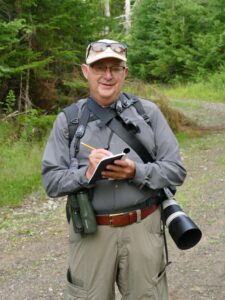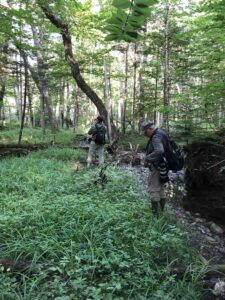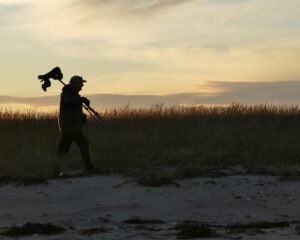Volunteer of the Month: Ken McKenna
14 Jul 2021
Our volunteer of the month is Ken McKenna, a passionate birder who contributes his expertise through our Birds Eye View program!
 Ken was not always a birder. In fact, he says, “I knew nothing about birds until I was in my mid-thirties.” He practiced dentistry for thirty-two years, and birding found its way into his life only once that practice was established enough that he had free time to get outdoors. “I think I just saw a bird I didn’t know while I was outside one day, and so I signed up for a course that was being advertised by the local vocational school. On one of the first field trips, guided by the late Harry Brennan, we saw three species of owls and I was hooked!” He immediately joined the Bird Society and started going out on field trips. “Next thing you know we’re traveling all over the place to see birds – I’ve been to a lot of countries birding. I would go almost anywhere for birds. It’s been so rewarding!”
Ken was not always a birder. In fact, he says, “I knew nothing about birds until I was in my mid-thirties.” He practiced dentistry for thirty-two years, and birding found its way into his life only once that practice was established enough that he had free time to get outdoors. “I think I just saw a bird I didn’t know while I was outside one day, and so I signed up for a course that was being advertised by the local vocational school. On one of the first field trips, guided by the late Harry Brennan, we saw three species of owls and I was hooked!” He immediately joined the Bird Society and started going out on field trips. “Next thing you know we’re traveling all over the place to see birds – I’ve been to a lot of countries birding. I would go almost anywhere for birds. It’s been so rewarding!”
Now that he is retired, he can spend as much time birding as he likes – and that is a lot. “This time of the year, I do a lot of monitoring of breeding birds,” he explains. “I’m involved in a number of bird studies with Birds Canada. I do Nightjar and Breeding Bird Surveys on three routes in Antigonish-Guysborough. In winter, I participate in six or seven Christmas bird counts.” Starting in spring, he usually does the Atlantic Nocturnal Owl Surveys on several routes. For about 20 years he has been monitoring the roost of Chimney Swifts in New Glasgow when they return in early May from overwintering in the Amazon Basin. He has been monitoring Piping Plovers since about ‘91. He was regional coordinator for the Antigonish area on the last Atlantic Breeding Bird Atlas and is gearing up to head to Newfoundland in early July to volunteer on their Breeding Bird Atlas. In trying to become a more rounded naturalist he has done field work for both the Maritime Butterfly Atlas and the PEI spider census. “I help out because organizations can’t always get to all the places they want to survey.”
That help includes surveying lands that the Nature Trust protects or is targeting for possible protection. “I started surveying potential properties along the St. Mary’s River for the Nature Trust when they were looking to protect some very high-profile lands.” Ken has found these missions especially interesting because “I don’t think I would have ever gone to those properties otherwise and wouldn’t have realized how lovely they are. So that’s a great bonus of being asked to do it – you really get to see why these are being set aside.”
 In the face of alarming numbers showing rapid declines in bird populations all over the world, bird data from volunteers like Ken helps organizations like the Nature Trust monitor the health of bird populations and habitats. “You’re already doing it, so why not share what you’re finding?” he explains. Whether it is more formal surveys and population counts, or informal BioBlitz-style visits, birders simply share their data through popular apps like iNaturalist and eBird.
In the face of alarming numbers showing rapid declines in bird populations all over the world, bird data from volunteers like Ken helps organizations like the Nature Trust monitor the health of bird populations and habitats. “You’re already doing it, so why not share what you’re finding?” he explains. Whether it is more formal surveys and population counts, or informal BioBlitz-style visits, birders simply share their data through popular apps like iNaturalist and eBird.
“The monitoring gives you a base to see how things are changing. If protecting a property can stop something from declining, and our data helps stimulate that action, that makes it all worthwhile,” he says.
Many people discovered an interest in birding during the pandemic; that makes perfect sense to Ken because “you can do it outside, by yourself, even just in your own backyard.” And with modern apps like eBird or Merlin Sound, even beginning birders can just hold a smartphone out to the sound and it will tell you the possible bird options! There are so many easier ways to learn than when I was starting. All you really need is binoculars and a phone app.”
 Nonetheless, Ken’s advice for anyone interested in taking up birding is to find an experienced birder to go out with, ask questions, and start to learn what you are hearing.
Nonetheless, Ken’s advice for anyone interested in taking up birding is to find an experienced birder to go out with, ask questions, and start to learn what you are hearing.
As you get more experienced, he says, you start to learn the rhythm of the birds. “You study the seasonal happenings. You get an idea of what arrives on what date, what leaves on what date, what stays for the winter. You go somewhere because you know what should be back by now, and you get excited when you see it back again. Great Blue Herons will come to a certain spot in the springtime, and you wait for them and are happy to see when they do come back again!”
Birders like Ken truly help conservation efforts while doing what they love – and the Nature Trust is so thankful for this important contribution. Learn more about our Bird’s Eye View program and how you can be part of this work.
